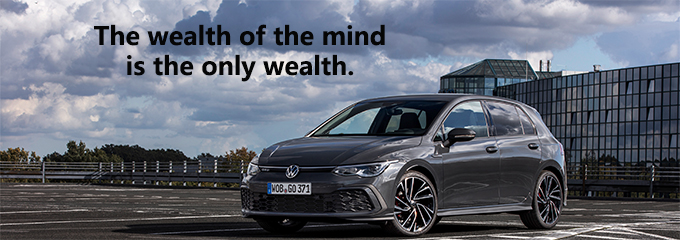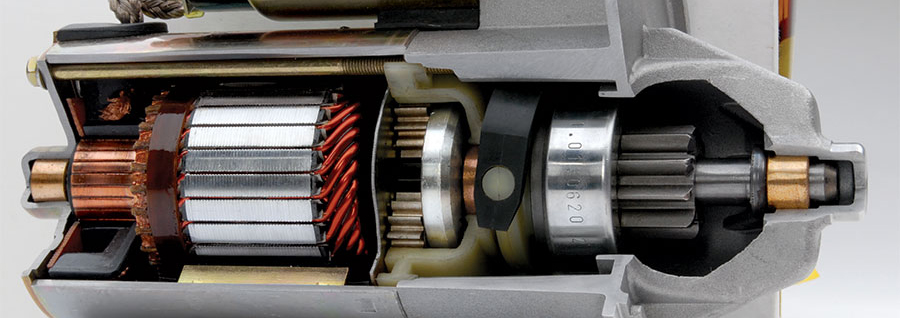
The starter motor is a small device with a clutch and variable speed mechanism. It has big power and good resistance to temperature. The starter can drive large internal combustion engines. Most internal combustion engines are powered by DC electric starters, which have features of compactness, simplicity of operation and ease of maintenance.
The automotive starter motor is made up of a DC motor, a steering mechanism and a clutch mechanism. It requires strong torque for operation. Therefore a large electrical flow is passed. The torque is high at low speeds and gradually decreases at higher speeds.
The rotor and stator parts of the starter are wound with relatively thick copper wire of rectangular cross-section. The drive mechanism is of reduction gear construction. The steering mechanism is of electromagnetic magnetic suction.
The power output structure is divided into two parts: the armature shaft and the drive shaft. The armature shaft is supported by ball bearings at both ends, which provides uniform load distribution, long service life, less wear, and a shorter armature, which is less likely to bend the armature shaft and wear out the magnetic field windings.
The reduction device is fitted with a gear between the rotor and the starting gear. This component increases the torque transmitted by the starting motor to the starting gear.
The electromagnetic switch makes the starter gear and the starter gear shaft take on the motor's power output (after the reduction gear), while the engage switch does not move.
Starter motors with low output power often use the external meshing mode, while those with high output power use the internal meshing mode.

The deceleration starter is controlled by an electromagnetic switch, some of which are equipped with an auxiliary switch (or sub-switch). It prevents the electromagnetic switch from burning out.
The staged power-on mode significantly reduces the likelihood of starter damage and thus extends the starter's service life.
The size and weight of a speed-reducing starter are approximately half that of a conventional starter, saving on raw materials and making it easy to disassemble and repair.
The winding of the magnetic field coil is often done in series with multiple small wires. The winding of the armature winding is the same principle as the traditional one, but the manufacturing process is more advanced.
A starter with a gear reducer between the armature shaft and the drive gear is called a reduction starter. The power of a series-excited DC motor is proportional to the torque and speed.
When the motor speed increases while reducing the torque, the starter power can be stable. Therefore, when a high-speed, low-torque series-excited DC motor is used as a starter, the size and mass of the device can be significantly reduced with the same power.
However, the too weak torque of a starter motor cannot meet the requirements for engine starting. For this reason, when a high-speed, low-torque DC motor goes into service, the torque can be increased by installing a gear reducer between the armature shaft and the drive gear.
The speed of the motor rotor of a reduction starter is higher than that of a normal starter, which drives the clutch directly, whereas a reduction starter uses a reduction gear to drive the clutch. The speed reduction and torque increase are achieved.
The benefits of this equipment are the low failure rate and the use of bearings for the rotor, which protects the rotor and stator better than the ordinary copper jacketed type of starter.

The starting time is too long. The starter doesn't work for the required time (about 5s to 10s). The device has been used for a long time without identifying the cause.
When the brush wears to 1/2 of the original length, the brush should be replaced. The brush height and contact should be checked regularly when maintaining the starter. Problems should be eliminated in time. Otherwise, it will cause the starter to waste.
There may be issues, such as poor contact of the solenoid switch, one-way teeth, damaged flywheel teeth and poor ironing. They can cause starter failure.
Try to start the engine no more than 5 seconds at a time, with an interval of 2-3 minutes. If it fails to start three times in a row, the starter should be checked and repaired.
When starting in winter, the crankshaft must be rotated several times and warmed up for about 15 minutes before starting the motor.
If the drive gear is not engaged in the gear ring and is running at high speed, the starting process should be stopped quickly and started again after the motor has stopped. The button should be released immediately after the ignition to return the drive gear to the original position.
The starter should be checked and cleaned regularly. Remove the dust belt and check the contact between the surface of the rectifier and the carbon brush.
The surface of the rectifier should be smooth and clean. The contact surface should be greater than 85%. The height of the carbon brush should not be less than 7 mm. The carbon brush spring pressure should be 8.8-12.7 Pa.
If the surface of the rectifier is not smooth, polish it with "0" grit sandpaper. The carbon brush spring pressure should be adjusted or replaced if it is lower than 8.8 Pa.
Check the surface of the electromagnetic switch contact. If it is burnt or has black spots, use sandpaper to polish it off.

A new car has a starting problem. The noise of the gears fighting can be heard. Try several times, and then the engine can start. Replacing the starter motor doesn't solve the problem.
When the engine flywheel was removed, it was discovered that two large areas of the ring on the flywheel disc had been damaged.
The reason is that when the key is turned to start the engine, the pinion gear protruding from the starter motor is introduced at a different angle. It can't be inserted into the flywheel ring smoothly. A gear clash and noise occur.
It is very rare that a new car can not start and the flywheel ring is damaged. Usually, it is only after the vehicle has been running for a long time that the gears fight, or you can hear the clear motor noise, and the engine does not work.
Modern cars have good ride comfort and sound insulation. We often sit in the cabin without hearing the engine's sound and often subconsciously turn the key to start the engine, only to be surprised when we hear the clicking of the gears. At this time, we have already caused some damage to the starter motor and engine flywheel ring.
If the flywheel is damaged a few times, it is possible to break or flatten the upper teeth, which may result in a situation where the battery and motor are working, but the engine will not start.
For example, if you turn the key and the starter motor turns fast and powerfully, but the engine does not move, it is because the pinion of the starter motor is sticking into the part of the flywheel where the ring teeth have been knocked out.

If it's a manual car, you can put the car into gear and push it forward or backward. Let the wheels drive the engine. Wait for the flywheel ring to turn at an angle so that the lost teeth are no longer aligned with the motor pinion. Then you can turn the car key and start the engine.
This issue can be a trouble for automatic cars. It is difficult and expensive to repair by replacing the starter motor or flywheel.
It is a good habit to look at the engine tachometer before turning the key when driving. If you see the needle at 0.7 or 0.8, you will know that the engine is idling, so you should not turn the key.
If the starter needs to be tapped before the car can start, in most cases, this is due to poor contact between the carbon brushes and the copper rotor head (commutator).
For example, if the carbon brushes have shortened in length after excessive wear, this can be repaired by dismantling the starter and replacing the brushes.
Turn on the ignition switch, the starter relay is activated, and the solenoid switch is connected to the power supply's positive side. The car can be started under normal circumstances.
However, if there is no response after switching on and the starter does not move, you should consider two problems.
First, check if the relay contacts are damaged or corroded. This can be determined by measuring the output voltage of the starter relay. If there is no voltage output for the action, change the relay.
It is also possible to determine if the starter relay is damaged by supplying power directly to the solenoid switch coil. Once the solenoid coil is connected to the positive side of the power supply, the other end needs to be connected to the negative side of the power supply to form a circuit. Then, the device can get to work.
The negative terminal of the solenoid switch is used to form a circuit through the starter motor. The current flows through the solenoid switch coil and enters the stator coil. The coil is in series with the rotor coil, so the current also flows through the rotor coil.

The connection between the rotor and the negative terminal relies on the carbon brush and the copper head. If the carbon brushes do not contact the copper head, the solenoid switch coil does not get a circuit.
As a result, the starter does not work correctly either. In this case, the problem can be solved by replacing the carbon brush with a new one.
 Lauritz Carolsfeld
Lauritz Carolsfeld  April 23, 2022
April 23, 2022